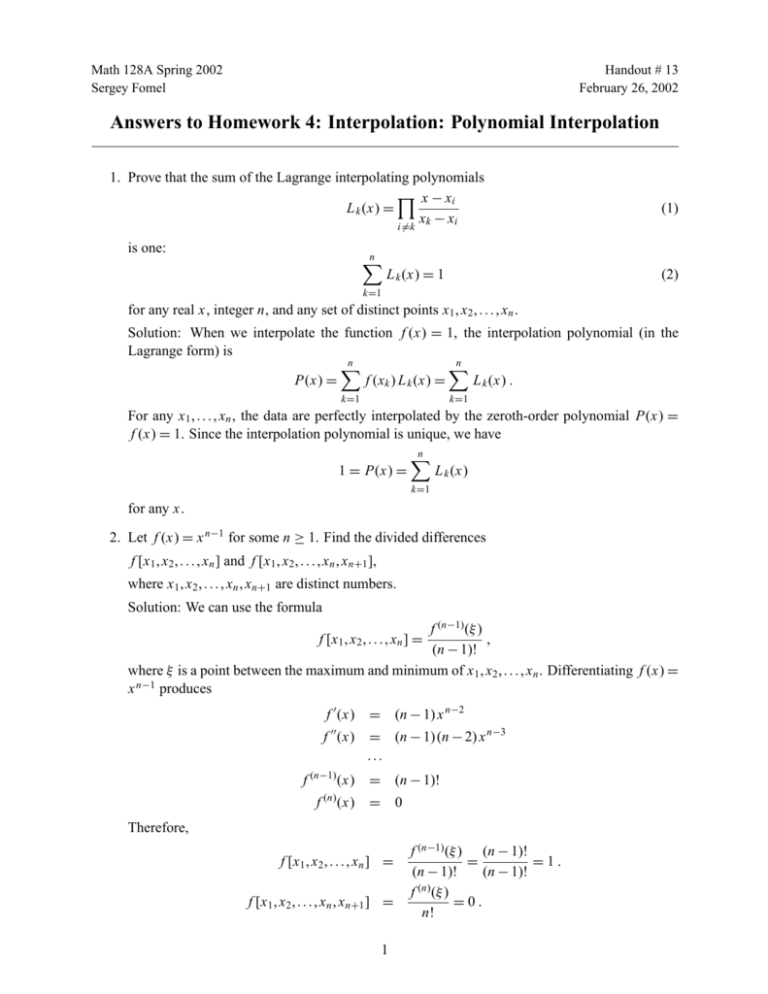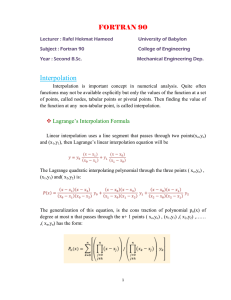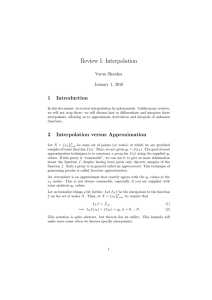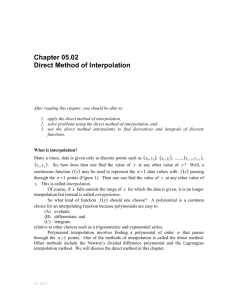Answers to Homework 4: Interpolation: Polynomial Interpolation
advertisement

Math 128A Spring 2002
Sergey Fomel
Handout # 13
February 26, 2002
Answers to Homework 4: Interpolation: Polynomial Interpolation
1. Prove that the sum of the Lagrange interpolating polynomials
Y x − xi
L k (x) =
xk − xi
(1)
i6=k
is one:
n
X
L k (x) = 1
(2)
k=1
for any real x, integer n, and any set of distinct points x1 , x2 , . . . , xn .
Solution: When we interpolate the function f (x) = 1, the interpolation polynomial (in the
Lagrange form) is
n
n
X
X
P(x) =
f (xk ) L k (x) =
L k (x) .
k=1
k=1
For any x1 , . . . , xn , the data are perfectly interpolated by the zeroth-order polynomial P(x) =
f (x) = 1. Since the interpolation polynomial is unique, we have
1 = P(x) =
n
X
L k (x)
k=1
for any x.
2. Let f (x) = x n−1 for some n ≥ 1. Find the divided differences
f [x1 , x2 , . . . , xn ] and f [x1 , x2 , . . . , xn , xn+1 ],
where x1 , x2 , . . . , xn , xn+1 are distinct numbers.
Solution: We can use the formula
f (n−1) (ξ )
,
(n − 1)!
where ξ is a point between the maximum and minimum of x1 , x2 , . . . , xn . Differentiating f (x) =
x n−1 produces
f [x1 , x2 , . . . , xn ] =
f 0 (x)
=
(n − 1) x n−2
f 00 (x)
=
(n − 1) (n − 2) x n−3
···
f
(n−1)
(x)
=
(n − 1)!
(n)
(x)
=
0
f
Therefore,
f [x1 , x2 , . . . , xn ] =
f [x1 , x2 , . . . , xn , xn+1 ] =
1
f (n−1) (ξ ) (n − 1)!
=
=1.
(n − 1)!
(n − 1)!
f (n) (ξ )
=0.
n!
3.
(a) Consider a set of regularly spaced nodes on interval [a, b]:
h=
b−a
,
n
xk = a + (k − 1) h ,
k = 1, 2, . . . , n + 1 .
(3)
Prove that the polynomial
N (x) = (x − x1 ) (x − x2 ) · · · (x − xn+1 )
(4)
satisfies
|N (x)| ≤ n! h n+1 ,
a≤x ≤b
(5)
Solution: For any x ∈ [a, b], let xk1 be the node
closest to x. The distance x − xk1 ≤ h.
If xk2 is the next closest node, then x − xk2 ≤ h. Similarly,
x − xk ≤ 2 h
3
x − xk ≤ 3 h
4
x − xk
···
≤ nh
n+1
Therefore,
|N (x)| = |x − x1 | |x − x2 | · · · |x − xn+1 | = x − xk1 x − xk2 · · · x − xkn+1 ≤ h · h · 2 h · · · · · n h = n! h n+1 .
Note: There is, in fact, a tighter bound
|N (x)| ≤
n! n+1
h
,
4
but it is a little bit more difficult to prove.
(b) Using the result of problem (a), prove that if f (x) = e x and Pn (x) is the interpolating
polynomial of order n defined at the n + 1 regularly spaced nodes
xk =
k −1
,
n
k = 1, 2, . . . , n + 1
(6)
then the interpolation error
en = max | f (x) − Pn (x)|
0≤x≤1
(7)
goes to zero as n goes to infinity:
lim en = 0
n→∞
Solution: The error of polynomial interpolation is
f (x) − Pn (x) =
2
f (n+1) (ξ )
N (x) ,
(n + 1)!
(8)
where ξ is a point in [0, 1]. Therefore,
eξ
e
en = max | f (x) − Pn (x)| ≤ max
n! h n+1 =
0≤x≤1
0≤ξ ≤1 (n + 1)!
(n + 1)
n+1
1
n
Since the limit of the right hand side is zero:
e
lim
n→∞ (n + 1)
n+1
1
=0,
n
we can conclude that
lim en = 0 .
n→∞
4. (Programming) Implement one of the algorithms for polynomial interpolation and interpolate
(a) hyperbola f (x) =
√
1 + x2
1.4
1.3
1.2
1.1
1
-1
-0.5
(b) Runge’s function f (x) =
0
0.5
1
0
0.5
1
1
1+25 x 2
1
0.8
0.6
0.4
0.2
0
-1
-0.5
using a set of n + 1 regularly spaced nodes
xk = −1 +
2 (k − 1)
,
n
3
k = 1, 2, . . . , n + 1 .
Take n = 5, 10, 20 and compute the interpolation polynomial Pn (x) and the error f (x) − Pn (x)
at 41 regularly spaced points. You can either plot the error or output it in a table. Does the
interpolation accuracy increase with the order n?
Answer:
−3
1
x 10
0.5
0
−0.5
−1
−1.5
(a)
−2
−1
−0.8
−0.6
−0.4
−0.2
0
0.2
0.4
0.6
0.8
1
−0.8
−0.6
−0.4
−0.2
0
0.2
0.4
0.6
0.8
1
−5
3
x 10
2.5
2
1.5
1
0.5
0
−0.5
−1
4
−8
2
x 10
1
0
−1
−2
−3
−4
−5
−1
−0.8
−0.6
−0.4
−0.2
0
0.2
0.4
0.6
0.8
1
The maximum error decreases (accuracy increases) with the increase of the polynomial
order.
0.5
0.4
0.3
0.2
0.1
0
−0.1
(b)
−0.2
−1
−0.8
−0.6
−0.4
−0.2
0
0.2
0.4
0.6
0.8
1
−0.8
−0.6
−0.4
−0.2
0
0.2
0.4
0.6
0.8
1
0.5
0
−0.5
−1
−1.5
−2
−1
5
40
35
30
25
20
15
10
5
0
−5
−1
−0.8
−0.6
−0.4
−0.2
0
0.2
0.4
0.6
0.8
1
The maximum error increases (accuracy decreases) with the increase of the polynomial
order.
5. (Programming) Repeat the experiments of the previous problem replacing the regularly spaced
nodes with nodes
π (k − 1)
, k = 1, 2, . . . , n + 1 .
xk = cos
n
Compare the accuracy.
−3
1.5
x 10
1
0.5
0
−0.5
−1
−1.5
(a)
−2
−1
−0.8
−0.6
−0.4
−0.2
0
0.2
0.4
6
0.6
0.8
1
−6
2.5
x 10
2
1.5
1
0.5
0
−0.5
−1
−1.5
−2
−2.5
−1
−0.8
−0.6
−0.4
−0.2
0
0.2
0.4
0.6
0.8
1
−0.8
−0.6
−0.4
−0.2
0
0.2
0.4
0.6
0.8
1
−0.8
−0.6
−0.4
−0.2
0
0.2
0.4
0.6
0.8
1
−10
1.5
x 10
1
0.5
0
−0.5
−1
−1.5
−1
0.7
0.6
0.5
0.4
0.3
0.2
0.1
0
(b)
−0.1
−1
7
0.1
0.05
0
−0.05
−0.1
−0.15
−1
−0.8
−0.6
−0.4
−0.2
0
0.2
0.4
0.6
0.8
1
−0.2
0
0.2
0.4
0.6
0.8
1
0.02
0.015
0.01
0.005
0
−0.005
−0.01
−0.015
−1
−0.8
−0.6
−0.4
Now, in both cases, the maximum error decreases (accuracy increases) with the increase of the
polynomial order. The second method of placing the interpolation nodes leads to more accurate
results.
Solution: C program
#include
#include
#include
#include
<stdlib.h>
<math.h>
<stdio.h>
<assert.h>
/*
/*
/*
/*
for
for
for
for
allocations */
mathematical functions */
output */
assertion */
/*
Lagrange interpolation
n
- number of points
x
- where to evaluate
xk[n] - nodes
fk[n] - function values
*/
double lagrange (int n, double x, double* xk, double* fk)
{
int i, k;
double p, lk;
8
p = 0.;
for (k=0; k < n; k++) {
lk = 1.;
for (i=0; i < n; i++) {
if (i==k) continue;
/* accumulate Lk(x) */
lk *= (x - xk[i])/(xk[k] - xk[i]);
}
/* accumulate the sum */
p += lk*fk[k];
}
return p;
}
/* test function */
static double func (double x, int function)
{
if (function == 1) {
return (sqrt(1. + x*x)); /* Hyperbola function */
} else {
return (1./(1. + 25*x*x)); /* Runge’s function */
}
}
/* main program */
int main (void)
{
const int function=2, method=2;
int i, k, n[]={5,10,20}, nx, ny=41;
double p, e, xk, *x, *y, *f, pi;
y = (double*) malloc (ny*sizeof(double));
assert (y != NULL);
/* regular grid for plotting */
for (k=0; k < ny; k++) {
y[k] = -1. + 2.*k/(ny-1.);
}
pi = acos(-1.); /* the number pi */
for (i=0; i < 3; i++) {
nx = n[i]+1;
/* allocate space */
x = (double*) malloc (nx*sizeof(double));
assert (x != NULL);
f = (double*) malloc (nx*sizeof(double));
assert (f != NULL);
/* build the table */
for (k=0; k < nx; k++) {
xk = (method == 1)? -1. + 2.*k/(nx-1.): cos(pi*k/(nx-1.));
f[k] = func(xk,function);
x[k] = xk;
}
/* evaluate the interpolation polynomial */
for (k=0; k < ny; k++) {
9
xk = y[k];
p = lagrange (nx, xk, x, f); /* polynomial */
e = func(xk,function)-p;
/* error */
/* print out the table */
printf("%d %f %f %g\n", k, xk, p, e);
}
free(x);
free(f);
}
free (y);
exit(0);
}
10










